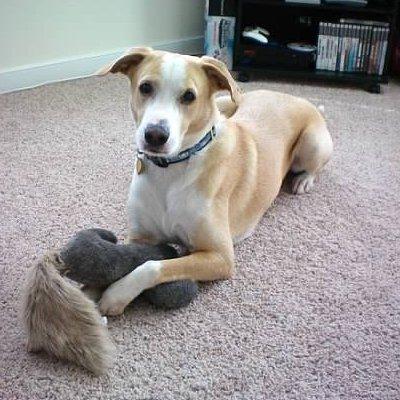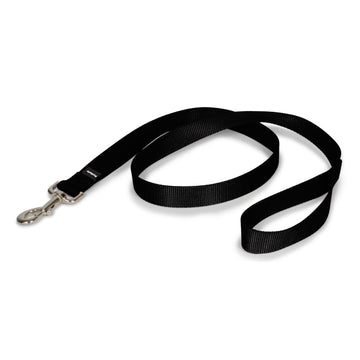By Stacie Mullins
“You have to come meet this dog. He would be perfect for you guys!” my sister called and said one day. Truer words were ever spoken. We adopted our Sprocket Man, as we call him, when he was 3 years old. He has the sweetest disposition and is the most chillaxed dog I’ve ever known. He quickly adjusted to life with us and it was extremely helpful that he already knew basic commands and was house broken (Yes, we know, we’re lucky). We quickly ascertained that he was extremely smart and we were able to teach him to lie down, stay, come, and heel (with the help of a Gentle Leader®) with ease. Our new life with Sprocket was perfect.
 However, as a couple of weeks passed we started to notice a few odd behaviors. He would often run into a wall, coffee table, chair, and us. At the time we just assumed he was still acclimating to the layout of the house or was just moving too quickly out of excitement. One day we decided to teach Sprocket how to play fetch with a Frisbee. My husband had him sit in front of him and he threw the Frisbee. Sprocket didn’t even move or flinch. He just sat there staring at my husband and sniffing up toward him. At this point we knew something wasn’t right.
However, as a couple of weeks passed we started to notice a few odd behaviors. He would often run into a wall, coffee table, chair, and us. At the time we just assumed he was still acclimating to the layout of the house or was just moving too quickly out of excitement. One day we decided to teach Sprocket how to play fetch with a Frisbee. My husband had him sit in front of him and he threw the Frisbee. Sprocket didn’t even move or flinch. He just sat there staring at my husband and sniffing up toward him. At this point we knew something wasn’t right.
We both waved our hands in front of Sprocket’s face and he moved his eyes somewhat but not the way he should have. The next day I made an appointment with the vet. Our veterinarian checked Sprocket’s eyes and said they weren’t dilating properly. He said this could be causing some problems with depth perception however he recommended that we see an eye specialist.
The next week I took Sprocket to the specialist. He examined him and then looked up to me and said, “Your dog is blind.” Of course my reaction to him was, “Excuse me? He’s not blind.” The doctor then proceeded to tell me that Sprocket had a genetic disease that destroyed the rods and cones in his eyes and that he had been losing his sight since birth. At this point Sprocket may be able to see some light and therefore shadows but very little else. The doctor then proceeded to tell me that Sprocket would probably lose that ability within a few months if not the year.
I could not believe what I was hearing. I told the doctor that it didn’t make any sense because no one had noticed this and Sprocket was able to get around so well. He explained they learn to adapt and learn to rely on their other senses even more. The people at the adoption agency probably didn’t notice because he was always in a small room/cage or on a leash being walked/guided.
I asked if there was anything we could do to halt the progression or slow it down and he simply said, “No, unfortunately not.” He explained that Sprocket would still be able to live a very full life and that we would have to train him and play with him a bit differently than a seeing dog. We would have to be his guides. I thanked the doctor and Sprocket and I made our way back to the car.
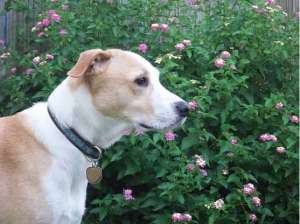 I broke down in tears as soon as I closed the car door. I was just so sad for Sprocket. As I sat there and cried I looked back at Sprocket and he was sitting in the back seat with his tail just wagging back and forth. He didn’t care. I believe he was more interested in where we were going next and probably wondered why I was a big blubbery mess.
I broke down in tears as soon as I closed the car door. I was just so sad for Sprocket. As I sat there and cried I looked back at Sprocket and he was sitting in the back seat with his tail just wagging back and forth. He didn’t care. I believe he was more interested in where we were going next and probably wondered why I was a big blubbery mess.
At that moment I realized that I wasn’t going to let this be a sad thing. Sprocket was healthy and happy and we would make sure he stayed that way. My husband and I immediately started researching blind dogs and with the help of my sister we learned different ways to train him that help him get around safely and easier.
“Wait” means stop. “Careful” means to slow down. “Step Up & Step Down” means just that. We snap our fingers in a particular spot that we want him to come to or use a treat. Appealing to his sense of smell and sound. We learned that squeaker toys are the best invention ever made.
We learned not to move anything without putting it back in its original location. It’s said that blind dogs make mental maps of places. It was described to us this way. Just like we have filing cabinets to keep things organized blind dogs create mental maps of locations they frequent often and file them away. When they enter a familiar space, a particular smell or sound can trigger them to pull the map of that place.
Because of this marvelous learned ability Sprocket is able to get around multiple familiar locations and our neighborhood with relative ease. We of course have to help guide him in new or unfamiliar locations. 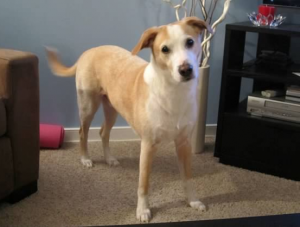 The biggest lesson has been to be mindful regarding how Sprocket’s blindness affects his ability to react with other dogs. Dogs learn many behaviors from each other. As a blind dog Sprocket has never been able to learn these behaviors and he of course can’t see when dog’s our exhibiting play or aggressive behaviors. This can cause some misunderstandings between him and other dogs.
The biggest lesson has been to be mindful regarding how Sprocket’s blindness affects his ability to react with other dogs. Dogs learn many behaviors from each other. As a blind dog Sprocket has never been able to learn these behaviors and he of course can’t see when dog’s our exhibiting play or aggressive behaviors. This can cause some misunderstandings between him and other dogs.
He also stares a lot which can unnerve other dogs. Because of this we have chosen not to take him to dog parks and other situations where there are lots of unleashed dogs. We are very up front with people about Sprocket’s condition and ask at times that they keep their dogs at a distance until we know how Sprocket will react/interact with them and vice versa.
It’s important to be a responsible dog owner with a seeing dog and even more so with a blind dog. 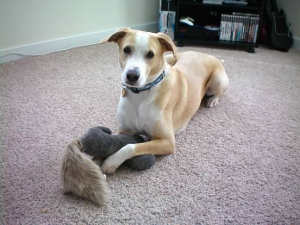 We’ve had Sprocket for 5 years now and he just turned 8. He brings more joy to our lives than we could ever measure. His blindness may cause him to be more cautious however he is no less loving and playful. He is the best dog and we are lucky to have him in our lives and wouldn’t change anything about him.
We’ve had Sprocket for 5 years now and he just turned 8. He brings more joy to our lives than we could ever measure. His blindness may cause him to be more cautious however he is no less loving and playful. He is the best dog and we are lucky to have him in our lives and wouldn’t change anything about him. 

